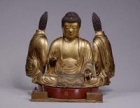Japanese Gallery (Honkan) Room 16
April 24, 2007 (Tue) - June 3, 2007 (Sun)
Hinagata refers to the various scale models, prototypes, sketches, and other steps in the creative process. Their uses included serving as mockups to confirm the design and teaching techniques to pupils.
Some objects on display only exist now as models; they include a statue of Buddha from Kyoto's Hokooji Temple, which was destroyed by fire in 1798; and the audience hall of the former Imperial Palace of the Emperor Meiji, which was destroyed by fire in 1945. Prince Shotoku (574-622) is said to have played with a set of black-lacquered armor and helmet as a child; the original is held by the Imperial Household Agency, but a model is featured here. A highly detailed paper model of the Flying Cloud Pavilion at Nishi-Honganji Temple in Kyoto is also featured. Other items include one-quarter scale examples of imperial garments and decorative swords, eboshi hats, Edo-period hairstyles, paper decorations, ornamental knots, etc.
Hinagata models serve as a reference tool, allowing us to see past fashions and traditional techniques today.

